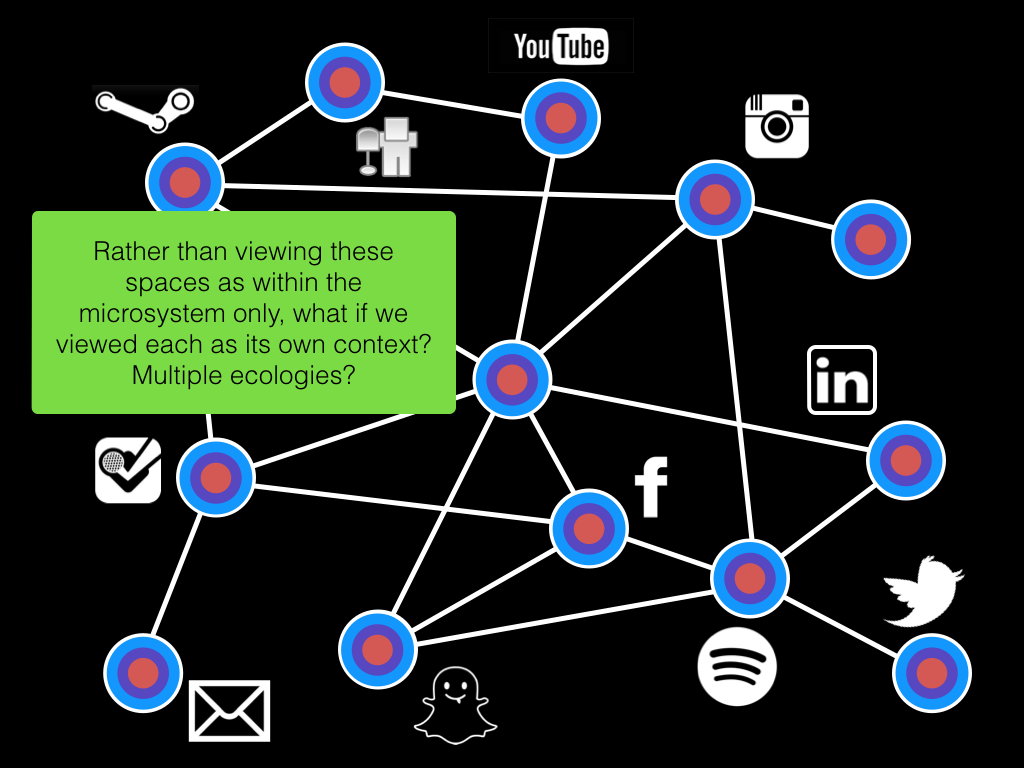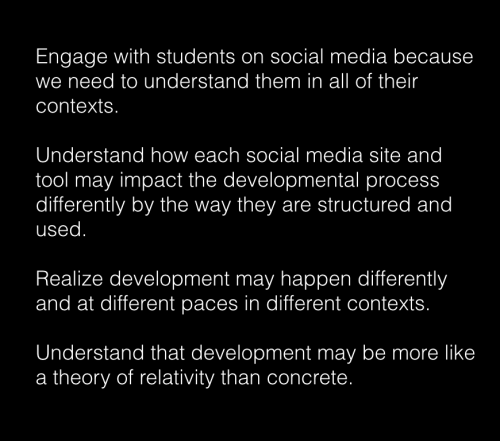(One of my colleagues and friends, Paul Eaton, wrote a great blog post about Bronfenbrenner’s applicability to online/social media spaces. I also wanted to have a go at the topic, so I purposely didn’t re-read his post until after publishing this one… and there’s agreement… but with a twist… read on…)
Urie Bronfenbrenner‘s theory of ecological development is a commonly taught theory in college student development courses. Although it was developed prior to the existence of the web, it nevertheless represents a highly useful tool for understanding the impact of the web on human development. The following post will present a way of understanding college student development in online and social media spaces. Because this theory is best understood visually, the above short video is included alongside the following text to help explain the concepts and questions I’m presenting below.
 First, a quick overview of Bronfenbrenner’s theory. (It will be short and painless, I promise.) Human ecology theories examine how an individual develops in relation to their “social surround.” In Bronfenbrenner’s theory, development occurs as a result of the interaction of a person and the environment. This “ecology” consists of four components process, person, context and time. The person, or college student is the focus of the development and possesses certain characteristics and personality traits that influence or impact the trajectory of their development. The person develops thorough proximal processes that are the interactions that spur or retard their development. All of this takes place through time and in context. Context is the component of the theory that is of most interest here, and it includes four components:
First, a quick overview of Bronfenbrenner’s theory. (It will be short and painless, I promise.) Human ecology theories examine how an individual develops in relation to their “social surround.” In Bronfenbrenner’s theory, development occurs as a result of the interaction of a person and the environment. This “ecology” consists of four components process, person, context and time. The person, or college student is the focus of the development and possesses certain characteristics and personality traits that influence or impact the trajectory of their development. The person develops thorough proximal processes that are the interactions that spur or retard their development. All of this takes place through time and in context. Context is the component of the theory that is of most interest here, and it includes four components:
- Microsystem: Activity and face-to-face interactions in the immediate environment. (roommates, family, sports teams, etc.)
- Mesosystem: Processes that take place between or as a result of microsystem contact and/or overlap. (campus culture, different role obligations, etc.).
- Exosystem: Influence an individual but do not directly include them. (School rules, financial aid policies, the NCAA, the Department of Education, etc.)
- Macrosystem: Overall contextual beliefs that influence the whole system. (American democracy, meritocratic notions, etc.)
As I stated earlier, Bronfenbrenner’s theory was created before the true advent of the web, but is nevertheless useful in understanding it. In Student Development in College, the authors write the following:
 Placing student interactions with others on social media, which may not be considered truly “face-to-face,” in the micro/mesosystem layer makes sense. “Virtual worlds” act very much similarly as “real worlds.” BUT What if we think about these spaces differently? What if they are, in themselves, separate contexts? Maybe even separate ecologies? This bends (perhaps even violates) Bronfenbrenner’s theory a little bit, but at the very least I think it brings forward some interesting questions.
Placing student interactions with others on social media, which may not be considered truly “face-to-face,” in the micro/mesosystem layer makes sense. “Virtual worlds” act very much similarly as “real worlds.” BUT What if we think about these spaces differently? What if they are, in themselves, separate contexts? Maybe even separate ecologies? This bends (perhaps even violates) Bronfenbrenner’s theory a little bit, but at the very least I think it brings forward some interesting questions.
 Let me explain. Each online social media site includes different microsystems of individuals. A student might have fellow athlete microsytems and student organization microsystems in these spaces. They may even have a microsystem that is entirely digital with no physical interactions with others at all.
Let me explain. Each online social media site includes different microsystems of individuals. A student might have fellow athlete microsytems and student organization microsystems in these spaces. They may even have a microsystem that is entirely digital with no physical interactions with others at all.
How students interact and form a culture in an online space may be a part of the mesosystem within a social media site. These mesosystems, too, may blended across physical and digital contexts or they may exist entirely online. Either way, there is a certain degree of ambiguity and relativity across this physical/digital divide. Can the same mesosystem context possess unique online, offline, and blended features?
 Social media sites were also set up and are subject to the whim of their designers. This would take place in the exosystem. (For example, the outrage you hear when Facebook changes its site or policy terms. Another example is how the “rules” of the social media site are coded. Can you friend someone without their needing to follow you back? What can you post and how long can it be?)
Social media sites were also set up and are subject to the whim of their designers. This would take place in the exosystem. (For example, the outrage you hear when Facebook changes its site or policy terms. Another example is how the “rules” of the social media site are coded. Can you friend someone without their needing to follow you back? What can you post and how long can it be?)
There are also our prevailing beliefs about social media in general. This would be the macrosystem. This may include ideas of anonymity and consequences, what is acceptable to post and not, and expectations of privacy. I would argue that many of these beliefs are still fluid, even though they may be coalescing around a core.
Students participate in multiple social media sites and networks. It follows, then, that students may have multiple overlapping contexts (and maybe ecologies) each with their own overlapping and relative systems in place. This is where we’re bending (breaking?) Bronfenbrenner’s theory a little bit. Contexts may exist entirely within physical and digital contexts or cross both. They may also affect each other differently and relatively (think Einstein here, and how the web can challenge our notions of time, place, etc.). If this is true, development is far more complex and relative. It may not be as unitary or as tidy as original theories would have one believe. A student might be more advanced in their development in one of these spaces than another. Rather than glomming social media onto Bronfenbrenner’s theory, why don’t we use its concepts to illuminate something new?
This causes us to question:
 And maybe change our practice to:
And maybe change our practice to:
I realize this may be a somewhat complex concept to understand, particularly for practitioners who may not have had the luxury of closely studying this theory for a while. If you haven’t done so, I encourage you to watch the video above. The visual explanation may help. Let me know what you think. Am I on to something? Is there something wrong with this line of thinking? Am I missing something?


